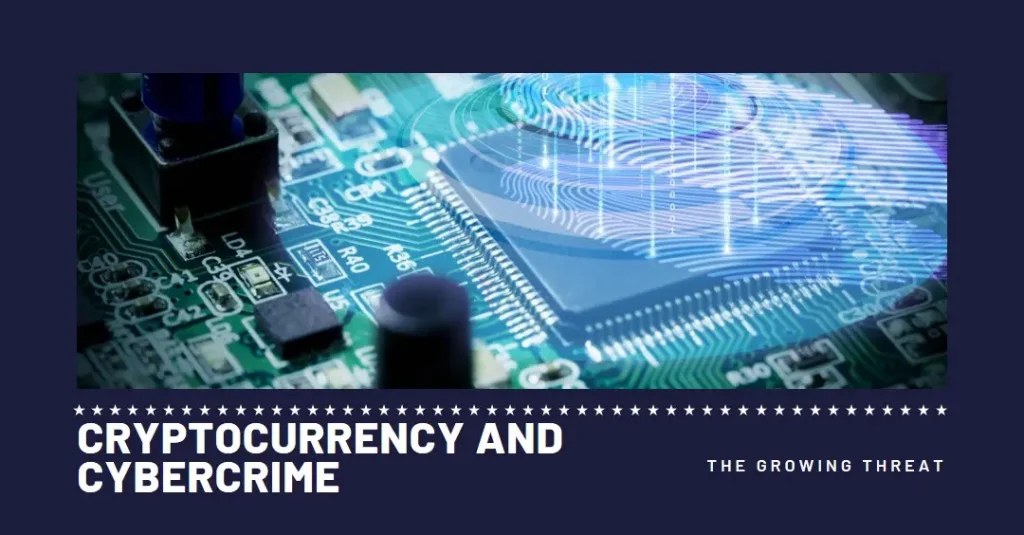Cryptocurrency and Cybercrime

Cryptocurrency has been making waves in the financial world for the past few years, and it shows no signs of slowing down.
While this new form of digital currency has many benefits, it has also attracted the attention of cybercriminals.
In this article, we’ll delve into the intersection of cryptocurrency and cybercrime, exploring the various ways that criminals are using cryptocurrency to commit crimes and how you can protect yourself
Before we dive into the world of cryptocurrency and cybercrime, it’s important to have a basic understanding of what cryptocurrency is.
At its most basic, cryptocurrency is a digital or virtual currency that uses cryptography for security and operates on a decentralized platform.
This means that it is not controlled by any central authority, such as a government or bank.
Some of the most well-known cryptocurrencies include Bitcoin, Ethereum, and Litecoin.
These currencies can be bought and sold on various cryptocurrency exchanges and used to purchase goods and services.
One of the key attractions of cryptocurrency is its decentralized nature.
Transactions are recorded on a public ledger called the blockchain, which allows for transparency and security.
Cryptocurrency also offers anonymity, as users do not need to reveal their personal information to make a transaction.
The Dark Side of Cryptocurrency
While cryptocurrency has many legitimate uses, it has also become a tool for cybercriminals. Here are some of the ways that criminals are using cryptocurrency to commit crimes:
- Ransomware attacks: Ransomware is a type of malware that encrypts a victim’s files until a ransom is paid. In many cases, the ransom must be paid in cryptocurrency in order to make it more difficult for law enforcement to track.
- Money laundering: Cryptocurrency offers a degree of anonymity, making it a popular choice for money launderers. These criminals can use cryptocurrency to transfer money across borders without detection.
- Fraud: There have been numerous instances of fraud involving cryptocurrency. For example, some scammers will create fake ICOs (initial coin offerings) and solicit investments from unsuspecting victims.
- Cyber extortion: Criminals may also use cryptocurrency as a means of extortion. For example, they may threaten to release sensitive information unless a ransom is paid in cryptocurrency.
Protecting Yourself from Cryptocurrency-Related Cybercrime
So, how can you protect yourself from cryptocurrency-related cybercrime? Here are a few steps you can take:
- Use a reputable cryptocurrency exchange: It’s important to use a reputable cryptocurrency exchange to buy and sell your digital currency. Do your research and choose an exchange that has a good track record of security.
- Enable two-factor authentication: Two-factor authentication is an extra layer of security that requires you to enter a code sent to your phone or email in addition to your password. This makes it much harder for criminals to gain access to your account.
- Use a hardware wallet: A hardware wallet is a physical device that stores your cryptocurrency offline. This means that it is much less vulnerable to hacking attempts.
- Be cautious of emails and messages requesting sensitive information: Cybercriminals may try to obtain your personal information or login credentials through phishing attacks. Be cautious of emails or messages that request sensitive information, and never click on links from unknown sources.
- Keep your software and devices up to date: Make sure to keep your software and devices up to date with the latest security patches. This will help to prevent vulnerabilities that could be exploited by cybercriminals.
Conclusion
Cryptocurrency has revolutionized the financial world, but it has also attracted the attention of cybercriminals.
It’s important to be aware of the various ways that criminals are using cryptocurrency to commit crimes and to take steps to protect yourself.
By using a reputable cryptocurrency exchange, enabling two-factor authentication, using a hardware wallet, being cautious of emails and messages requesting sensitive information, and keeping your software and devices up to date, you can significantly reduce your risk of falling victim to cryptocurrency-related cybercrime.
It’s also important to educate yourself on the latest trends and techniques used by cybercriminals.
Stay informed about the latest threats and how to protect yourself by following reputable sources of information and staying vigilant.
Cryptocurrency has the potential to revolutionize the way we handle financial transactions, but it’s important to be aware of the risks and to take steps to protect yourself.
By following these tips, you can enjoy the benefits of cryptocurrency while minimizing your risk of falling victim to cybercrime.







